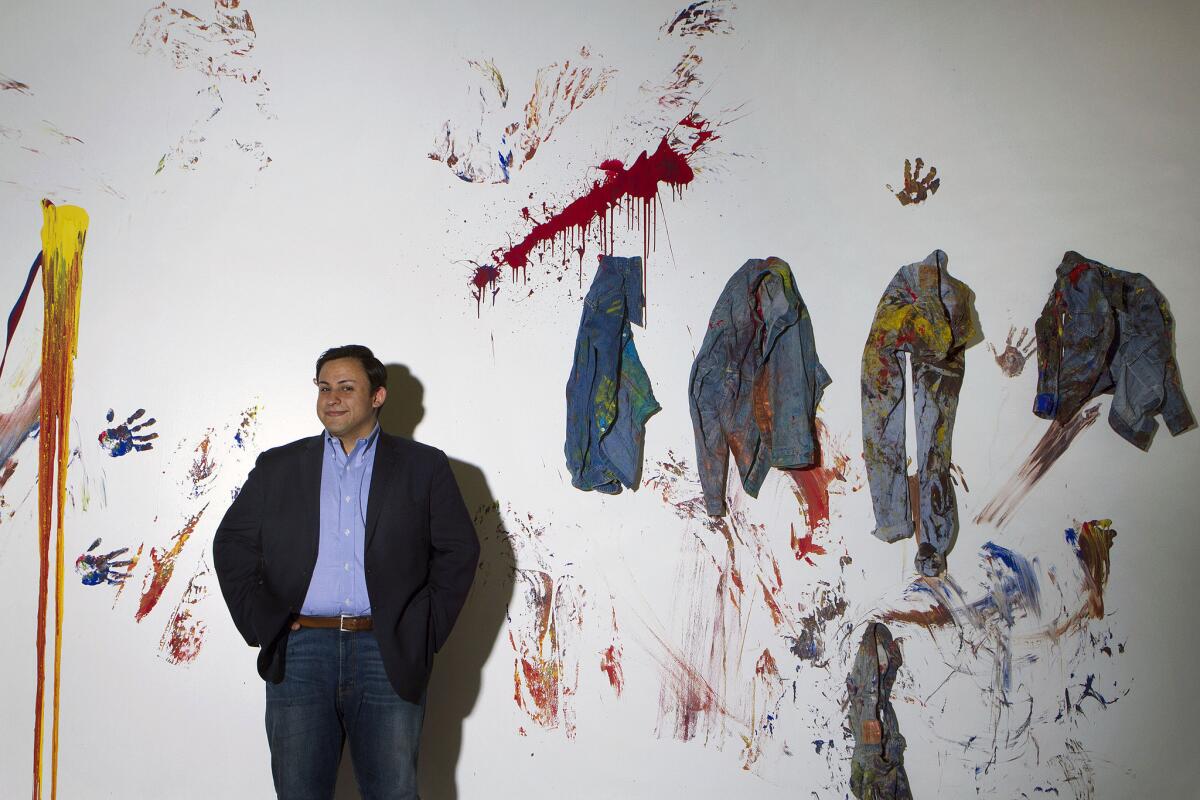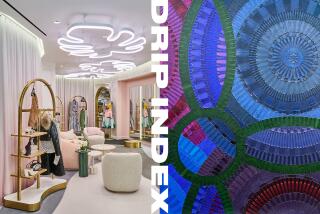The Mistake Room brings global view to gritty downtown L.A. art scene

Construction workers hammer away in a warehouse near the southern edge of downtown Los Angeles. A buzz saw hits fever pitch, screeching in the background; the air is thick with dust.
Art entrepreneur and curator Cesar Garcia, who is turning this former garment factory into a nonprofit exhibition space called the Mistake Room, rushes out from the back in a black dress shirt and Italian loafers, giddy if a bit frazzled. He cradles an armload of loose items — a leather binder stuffed with to-do notes, a cellphone, a tape measure, an envelope that needs to be mailed.
“Oh my god, I’m learning so much about sheetrock and construction,” the 28-year-old says, laughing. He shifts the bulk of the objects into the crook of one arm, freeing up the other for a handshake. “Welcome!” Then he turns and leads the way straight into the drywall dust storm. “Lemme show you around.”
The Mistake Room is the newest art space in a burgeoning but still gritty art enclave downtown. By night, the dark and deserted area bound by 20th Street, Washington Boulevard, Long Beach Avenue and Santa Fe Avenue is studded with lively pockets of art-going foot traffic. Night Gallery is around the corner, as is Francois Ghebaly Gallery, 2nd Cannons Publications, which puts on art shows, and the nonprofit research and exhibition space Fahrenheit/Flax Foundation.
Garcia, formerly associate director of the Culver City nonprofit LAXART as well as a curator of the Hammer Museum’s inaugural “Made in L.A. 2012” biennial, created the Mistake Room to feature contemporary artists and curators from around the world. The space debuted in January with a pop-up solo exhibition by London-based Colombian artist Oscar Murillo. The 4,500-square-foot warehouse space remained raw and unrenovated at the time, with cracked concrete floors and exposed insulation. The show closed in April, and the space has since undergone a redesign, led by Tijuana-based architect Alfonso Medina. The hard launch Friday features an exhibition by Bangkok-raised, New York-based artist Korakrit Arunanondchai, whose first solo museum show is on view at MoMA PS1.
“I’m excited. This is the artist’s biggest commission to date,” Garcia says. “This place is a dream, a long time in the making.”
The Mistake Room fills a niche in the city, Garcia says, joining LAXART, Los Angeles Contemporary Exhibitions in Hollywood, REDCAT downtown and the Santa Monica Museum of Art as mid-size, nonprofit, non-collecting exhibition spaces — entities that fall between commercial galleries and larger museums with permanent collections.
Such art spaces are particularly prevalent in Europe, Garcia says. Many of them — the Renaissance Society in Chicago, White Columns in New York, Kunsthalle Basel in Switzerland, among them — co-produce shows, and Garcia hopes to tap into that network. He wants to expose local artists, particularly students, to influences they might not otherwise come across as well as educate international curators about L.A. artists.
“We want to connect Los Angeles to other burgeoning regions of the world, art wise,” Garcia says. “We want to be the mid-sized institution that can collaborate with places like the Chisenhale Gallery and the Serpentine in London, Beirut Art Center or Vitamin Creative Space in Hong Kong. We want to be part of that conversation.”
In summer 2010, with funding from a Fowler Museum Latin American research grant he received while pursuing his doctorate at UCLA, Garcia traveled through Chile, Colombia, Peru and Brazil to research his dissertation on alternative art spaces. Two years later, after the Hammer biennial opened in 2012, he used his own savings (and, later, money from the Mistake Room’s nascent board started that fall) to set out for about six months traveling around the world, visiting art spaces and making connections.
“I wanted to make sense of what was happening in the art world in South America and the Middle East mostly, but I went to Europe too,” he says. “What are these spaces doing? What do the cultural infrastructures look like? What is the support for artists?”
In his travels, he talked with foreign curators about the L.A. art scene. Most were aware of L.A.’s reputation as a prolific visual art center, he says, but many also felt alienated by L.A.’s physical sprawl and car-dependent culture. That had deterred some from exploring the city.
“There are tangible consequences for artists working here — that their international exposure, particularly for young and emerging artists, isn’t as great as in other cities that may be more accessible,” Garcia says.
As part of its visiting curators program, Garcia says, the Mistake Room will bring three curators a year to L.A. from other countries for a residency of at least seven days; it will cover travel expenses, lodging, a stipend and a driver with an itinerary of artists’ studios to visit that guest curators may not have found on their own.
Hendrik Folkerts, curator of public programs at the Stedelijk Museum Amsterdam, is the first to participate. He started this week.
The residency “enables me to tap into the rich and extremely lively Los Angeles art scene, through an elaborate program of studio visits and institutional meetings,” Folkerts says. “This kind of exchange is essential for an international curatorial practice.”
The Mistake Room commissions original work for exhibitions; none of the art is for sale and admission is free. When shows close, the work goes back to the artists. If the artist sells that work at a later date, Garcia says he’d request a donation in the amount of exhibition costs.
The Arunanondchai show cost about $50,000 to $60,000 to put up, Garcia says. The Mistake Room’s recent renovation cost about $100,000, and operational costs include three full-time staff: Garcia, deputy director and senior curator Kris Kuramitsu and assistant curator and exhibition manager Grecia Santiesteban.
Launching the Mistake Room wasn’t easy for Garcia, who immigrated with his family from Mexicali when he was 6 and grew up in Pico-Union, an area he calls “the Ellis Island of L.A.” He’s still paying off student loans while finishing his doctorate.
“In terms of my parents’ social circles and individuals I was able to reach out to, I didn’t have access to resources or [wealthy] family friends,” he says.
Money for the Mistake Room comes from fundraising events and gifts, a “closed membership program” and a 14-person board with deep pockets. It includes former Santa Monica Museum of Art board chair Dr. V. Joy Simmons, now the Mistake Room’s board chair, Oprah Winfrey Network executive Tina Perry and CAA agent Thao Nguyen. In keeping with the Mistake Room’s vision, about a third of the board is from another country. Glenn Kaino, a founder of the now-defunct downtown L.A. art space Deep River, is one of four artist trustees. The Mistake Room has gotten 501(c)(3) status, so it can start applying for grants.
The membership program is limited to 40 patrons at a time, each of whom donates $20,000 annually in exchange for benefits: inclusion in international art trips to destinations such as the Venice Biennial, studio visits and participation in an “artists multiple program” in which they receive a piece of original artwork, four times a year, from a different artist. A board member in Guadalajara, Jose Noe Suro, underwrote the artists multiple program, covering the cost of producing the art.
It’s this part of the business model, however, that some people call questionable.
“They’re grooming artists to move up the institutional ladder and connecting those artists with collectors — people who’ve paid them a chunk to be members,” Coagula Curatorial gallery owner Mat Gleason says. “It’s insidious because it appears to be pure, since they’re a nonprofit rather than a commercial gallery, but there’s still commerce going on.”
Added Paul Kopeikin of Kopeikin Gallery: “Just because it’s a nonprofit doesn’t mean it’s pure or that people aren’t making money — as they deserve to. They’re just getting their money in a different way.”
Arunanondchai says he’s just grateful for a place like the Mistake Room.
“Art spaces in this kind of scale — if you were in New York and you wanted to do a project like this, you’d have to be with a museum or a big Chelsea gallery,” he says. “I like that it doesn’t feel commercial. It’s a dream project for me.”
Arunanondchai’s solo L.A. debut at the Mistake Room is “Letters to Chantri #1: The lady at the door/The gift that keeps on giving.” The installation of 100 mannequins, a “timed experience” that accommodates about 15 viewers at once, also includes paintings, sculptural elements and two short films Arunanondchai directed featuring performance artist Boy Child. The exhibit speaks to the commodification of Eastern religions as it focuses on a single character, a disillusioned artist, that Arunanondchai hopes to incorporate into a feature film.
The Mistake Room’s fall schedule includes two historical shows of abstract expressionist painters from the ‘50s and ‘60s, Matsumi Kanemitsu and Ed Clark. In September, Garcia and his team will screen the site-specific films of New York artist Gordon Matta-Clark and invite local artists, writers, choreographers and others to respond to them.
“We’re interested in their relationship to the city and what’s happening downtown,” he says as the Mistake Room’s construction crew shuts down for a break.
As the dust quite literally settles, Garcia looks out across his cavernous exhibition floor.
“Bringing in artists from other places, curators, we’re learning so much about our own city,” Garcia says. “It’s seeing L.A. through their eyes.”
Twitter: @debvankin
More to Read
The biggest entertainment stories
Get our big stories about Hollywood, film, television, music, arts, culture and more right in your inbox as soon as they publish.
You may occasionally receive promotional content from the Los Angeles Times.











